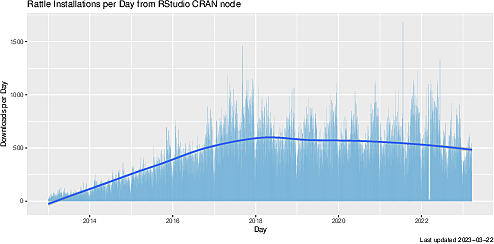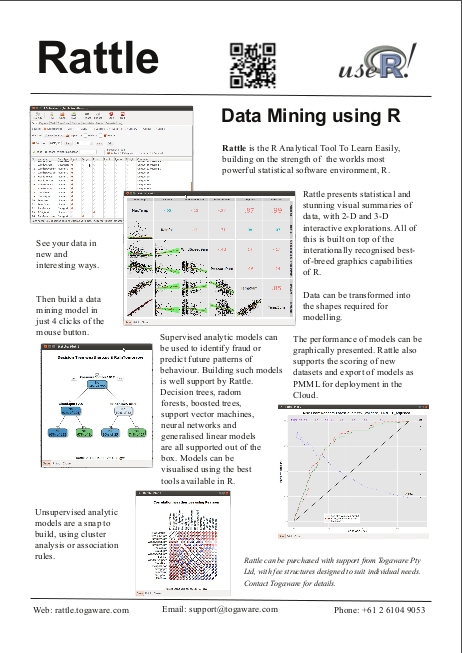R Gui Software Free Download
Rattle: A Graphical User Interface for Data Mining using R
Welcome to the R Analytical Tool To Learn Easily! Visit R Projects for Dummies for a recent introduction to Rattle. Also visit our Data Science Desktop Survival Guide to begin or continue your journey as a data scientist. Click below if you would like to donate to support the future development of Rattle.
Rattle is a popular GUI for data mining using R. It presents statistical and visual summaries of data, transforms data so that it can be readily modelled, builds both unsupervised and supervised machine learning models from the data, presents the performance of models graphically, and scores new datasets for deployment into production. A key features is that all of your interactions through the graphical user interface are captured as an R script that can be readily executed in R independently of the Rattle interface. Use it as a tool to learn and develop your skills in R and then to build your initial models in Rattle to then be tuned in R which provides considerably more powerful options.
Contributing: Rattle is Free (as in Libre) Open Source Software and the source code is available from the Bitbucket git repository. Anyone is welcome, and indeed invited, to clone the git repository and to contribute to its development through lodge pull requests.
We give you the freedom to review the code, use it for whatever purpose you like, and to extend it however you like, without restriction, except that if you then distribute your changes you also need to distribute your source code under the same conditions.
Rattle clocks between 10,000 and 20,000 downloads per month from the RStudio CRAN node (one of over 140 nodes).

Installation: Please check the open source software license (it is GPLv2) and then choose one of the specific installation instructions depending on your platform. The TL;DR version is to install R and then Rattle:
$ wajig install r-recommended $ R > install.packages("rattle") > library(rattle) > rattle() For the GUI operations you will also need:
> install.packages("RGtk2") To install all suggested packages (which are otherwise selectively installed as you interact with Rattle):
> install.packages("rattle", dependencies="Suggests") The development version is regularly updated and a list of the latest updates is available from the Commits on bitbucket. All known bugs are fixed in the latest development version. See the troubleshooting page to see if you have a new issue.
To install the latest development Version 5.4.13 dated 2021-08-27:
> install.packages("rattle", repos="https://rattle.togaware.com", type="source") To install from the source code repository:
> install.packages("devtools") > devtools::install_bitbucket("kayontoga/rattle") To install from the package tar file:
> install.packages("https://togaware.com/access/rattle_5.4.13.tar.gz", repos=NULL) You can also use Docker (install docker-ce) on Linux/Windows/Mac to run the Ubuntu-based Docker pre-built image for Rattle in a container.

Errata
 Brochure
Brochure
- Documentation
- Information
- Support
- Coding
- Other Resources
Reviews
"Rattle is a tab-oriented user interface that is similar to Microsoft Office's ribbon interface. It makes getting started with data mining in R very easy. This book covers both Rattle, the R code that Rattle creates, and writing some R code from scratch. Therefore it will appeal to both people seeking the ease-of-use that is very much missing from R, and people looking to learn R programming."
"The book is very enjoyable reading and is filled with useful information. It is aimed at both students learning data mining and data miners who are using or learning R. People are likely to read it through the first time as a text book and then later use it as a reference, especially about the details of the R language. One of the strongest aspects of this book is Dr. Williams' ability to simplify complex topics and explain them clearly. His descriptions of bagging and boosting are the most clear that I have ever read."
Bob Muenchen, author of R for SAS and SPSS Users, 30 June 2011
From Amazon:
For anyone looking to learn more about R, this would be a great introduction. Brian Tvenstrup (5 reviewers made a similar statement).
This book covers both Rattle, the R code that Rattle creates, and writing some R code from scratch. Robert A. Muenchen (2 reviewers made a similar statement).
In summary, I found the book very readable, the examples easy to follow, and the explanations and reasons for why different processes are done. G3N1U5 (2 reviewers made a similar statement).
Background
Rattle is open source and freely available from Togaware. You can download Rattle and get familiar with its functionality without any obligation, except for the obligation to freely share! Organisations are also welcome to purchase Rattle, including support for installation and initial training, and ongoing data mining support. Email rattle@togaware.com for details.
Through a simple and logical graphical user interface based on Gnome, Rattle can be used by itself to deliver data mining projects. Rattle also provides an entry into sophisticated data mining using the open source and free statistical language R.
Rattle runs under GNU/Linux, Macintosh OS/X, and MS/Windows. The aim is to provide an intuitive interface that takes you through the basic steps of data mining, as well as illustrating the R code that is used to achieve this. Whilst the tool itself may be sufficient for all of a user's needs, it also provides a stepping stone to more sophisticated processing and modelling in R itself, for sophisticated and unconstrained data mining.
Users
Rattle is in daily use by Australia's largest team of data scientists and by a variety of government and other enterprises, world wide. Whilst the true number of active users is hard to gauge we can observe that there are about 20,000 downloads of the package per month from a single thoug popular CRAN node (where CRAN has over 100 nodes).
Many independent consultants world wide also use Rattle in their day-to-day business.
Known users of Rattle include the College Raptor, RACQ, McMillan Shakespeare, University of Texas at Dallas, Public Transport Authority of Western Australia, New South Wales Department of Primary Industries, the University of California San Diego, the largest banks in India, Derby Dubai, Australia's ANZ and Commonwealth Banks, the Australian Taxation Office, Australian Department of Immigration, Ulster Bank, Toyota Australia, Victorian Cancer Council, US Geological Survey, Carat Media Network, Institute of Infection and Immunity of the University Hospital of Wales, US National Institutes of Health, AIMIA Loyalty Marketing, Added Value, Stanford University, V.E.S Institute of Technology Mumbai, Microsoft, Chevron, Siemens, and many more.
Rattle is also used to teach the practise of data mining. The software and the book are used as the primary tool of instruction for hands-on data mining and data science at the Australian National University, University of Canberra, Harbin Institute of Technology, Shenzhen Graduate School (since 2006), Australian Consortium for Social and Political Research (2011), Revolution Analytics (since 2012 and now Microsoft), International Centre for Free and Open Source Software in Kerala, India (2015) and many others.
Rattle is used in teaching data science at numerous universities, including: NYU School of Professional Studies (2020), Big Data Analytics @ UC San Diego (since 2017), University of South Dakota, the University of Washington Foster School (since 2017), the School of Global Policy and Strategy, UC San Diego (since 2016), the Australian National University's course on Data Mining (since 2006 and ongoing 2020), University of Canberra (2010-), University of South Australia (2009-), Yale University, University of Liège Belgium (2011-), University of Wollongong (2010-), University of Southern Queensland (since 2010), University of Technology, Sydney (2012-), Electrical Engineering courses in Reliability and Testability at Virginia University, Loyola University Chicago, Southern New Hampshire University (2017-), Penn State University (2017-), University of Washington (2016-), Swinburne University, among others.
Award
The author of Rattle received a 2007 Australia Day Medallion, presented by the Commissioner of Taxation, for leadership and mentoring in Data Mining in the Australian Taxation Office and in Australia, and particularly cited the development and sharing of the Rattle system. Other awards include to 2020 Special Achievement Award from the Pacific Asia Conference on Knowledge Discovery and Data Mining (PAKDD).
Citation
If you use Rattle please reference it according to citation("rattle"). You might also reference one of the following:
Graham Williams (2011). Data Mining with Rattle and R: The Art of Excavating Data for Knowledge Discovery, Springer, Use R!.
or
Graham Williams (2009). Rattle: A Data Mining GUI for R, Graham J Williams, The R Journal, 1(2):45-55.
Discussion Group and Suggestions
The Rattle Users mailing list is hosted by Google Groups. Questions and suggestions can be posted there. You can [visit the discussion archive] or subscribe by supplying your email address below and clicking the Subscribe button.
Copyright © 2006-2019 Togaware Pty Ltd
This site is hosted in the cloud by Web Faction.
Last Modified Wednesday 2020-10-07 13:35:24 AEDT Graham Williams

Shop at Amazon
Source: https://rattle.togaware.com/
Posted by: juliocomfort.blogspot.com